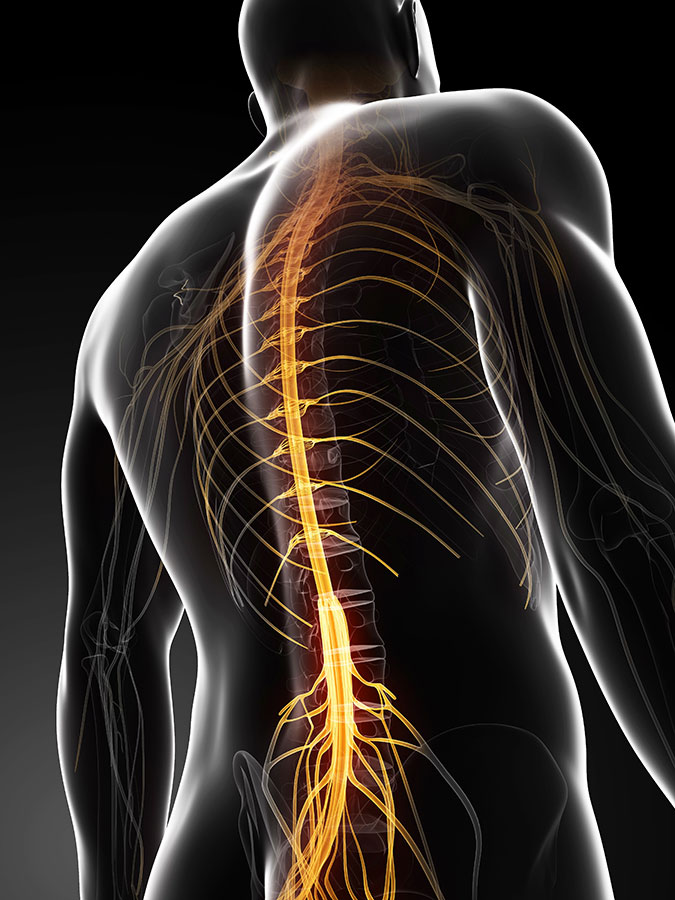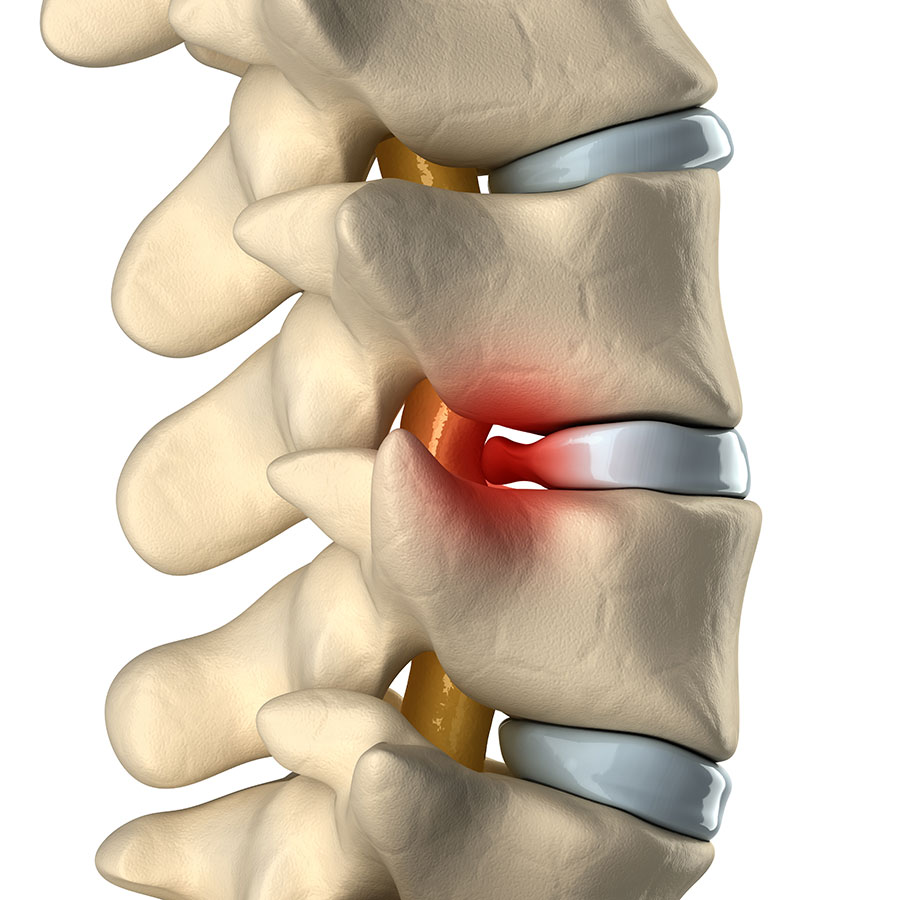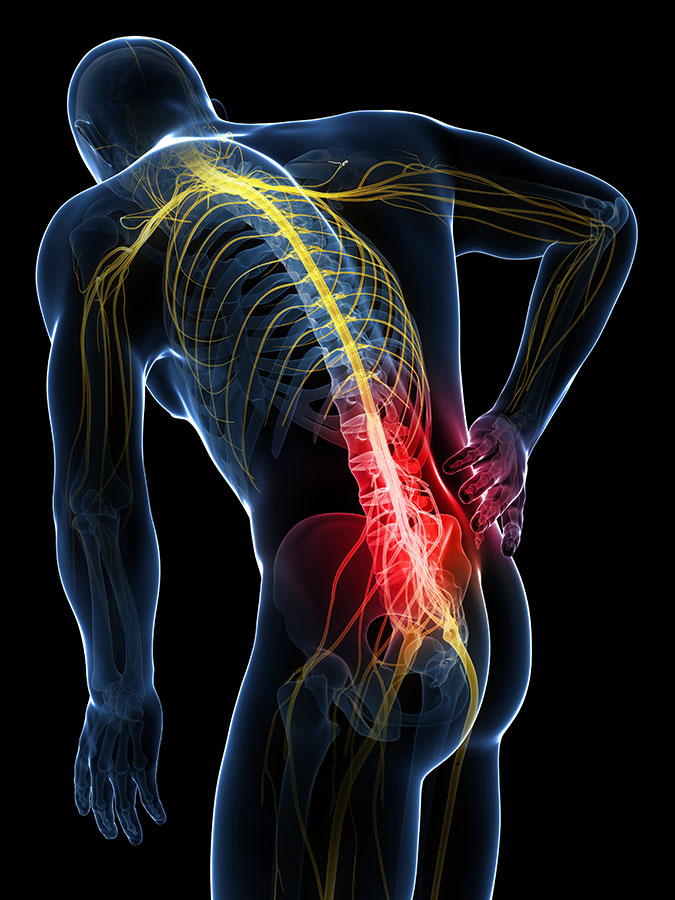Nerves are the structures that carry information and sends messages throughout our body. These are like long cables that extend from our brain to all over our body. Sometimes the bigger branches of nerves get irritated or pinched by Ligaments, bone, tendons or even just swelling around the nerve. As these nerves run out from your brain they exit the spinal cord and bundles together as they run along certain pathways to your arms or legs. Nerve pain is often experienced as a disturbance in sensation or a disruption in movement of the affected area, or along the course of the nerve. Giving it a characteristic “Radiating pain” (pain that travels to another area).
Damage to these branches of nerves can be very mild or very severe. It may even cause long-term problems if left untreated. The earlier you get a diagnosis and treatment for nerve compression, the more quickly you’ll find relief.
In some cases, you can’t reverse the damage from a pinched nerve. But treatment usually relieves pain and other problems that might occur.

Causes of pinched nerves
A pinched nerve occurs when there is compression (pressure) or irritation (friction) on one or more nerve branch. Nerves are most vulnerable at places in your body where they travel through narrow spaces and have very little soft tissue to protect them. Structures that can pinch a nerve are any place along the nerve pathway where it weaves between tissues like muscle, tendon, bone and ligaments.
Irritation
May be the result of repetitive movements. This may happen when you do a excessive repetitions at the gym, or doing the same movement over and over again. As the nerve slides over muscles, tendons and bone, it will become irritated and inflamed. The nerve’s outer protective barrier gets damaged and cause swelling, which causes extra pressure. Scarring may form around the nerve, which in turn disrupts its normal glide over the surrounding structures.
Entrapment
May be due to the surrounding structures that prevents the nerve from moving (sliding and gliding) as you move. This may happen when you were in a cast or after surgery. The pinched nerve is a secondary complication due to the immobility of the joints. The nerve gets trapped between the structures and its normal movement is compromised. This is also the end result of a untreated nerve compression and irritation.

Our experience with nerve pain
Nerve pain are the most sensitive pain that we as humans can encounter. For some reason we see that patients that experience nerve pain leave it for quite a long period of time. Nerve pain can last from weeks to months before it relieves, if any. We encourage you to rather have it looked at if you suspect a nerve is being pinched to avoid permanent damage.
The longer you wait before seeing a medical professional, the more damage you might cause to the nerve. Prevent slow healing and long rehab.
Symptoms of a pinched nerve
- Burning pain
- Pins & Needles
- Tingling
- Sharp/stabbing/shooting pain
- Electrical shock
- Numbness
- Unable to control movement
- Dead feeling over skin
- Pain at the area of compression (neck or lower back)
- Pain radiating (traveling) to the legs (Sciatica) or the arm
- Weakness when moving the affected limb

Neck pinched nerve
(Cervical Radiculopthy)
Pain radiating from either side of the neck, running down the arm into the shoulder, upper-arm, elbow, forearm or in the most severe cases the pain will radiate to the fingers.
Lower Back Pinched nerve
(Lumbar Radiculopathy)
Sciatica is one of the most common forms of nerve compression. Pain radiating from the lower back running down the buttock, into the hamstring, or around the front of the thigh, down the knee and into the calf and foot.
Physiotherapy treatment
Physiotherapists is the first person to consult. We will be able to get the correct diagnosis as to the cause of the pinched nerve and advise you to consult with a GP to prescribe adequate pain medication. We will write a report to you your GP detailing the severity of your case.
Professional healthcare treatment for sciatica should be conservative in nature firstly.
Other treatment approaches include: Rest and activity modification (identify the movement or position casing the nerve irritation), rehabilitative exercises, desk ergonomic advise, referral to a GP/specialist for pain killer medication, referral for x-ray or MRI scans.
Initially Physiotherapy treatment focuses on decreasing the nerve compression and irritation by using Ultrasound and Laser. We use Strapping and Taping to limit the range of movement of the affected leg or arm, to avoid any further injury.
Acupunctureor Dry Needling around the soft tissue of the nerve, promotes the inflammatory reaction and repair of injured tissue.Electrotherapy can be used to desensitize the nerve. Massage, Soft tissue mobilization along the nerve pathway and the interfaces where the nerve crosses between or certain compression points. Nerve tissue mobilization are vital in regaining the normal glide action of the nerve. Dynamic, static and ballistic stretches together with eccentric loading exercises to condition the muscle fibers. Myofascial release over the injury site to guide the scar tissue formation has proven very effective in chronic nerve pain syndromes.
Using self-treatment methods can cause further harm or delay the appropriate treatment needed.
When is surgery necessary?
Surgery for a pinched nerve is rare. Back surgery is only considered for a pinched nerve if the compression cannot be relieved by conservative treatment or if there is progressive neurological disturbance that threatens permanent loss of function.
What medications can help to relieve the pain?
- NSAIDs – Nonsteroidal anti-inflammatory drugs (NSAIDs) such as aspirin and ibuprofen may reduce swelling.
- Oral corticosteroids. These are used to reduce swelling and pain. (In more severe cases)
- Narcotics. Used for a few days to reduce severe pain.
- Steroid injections may reduce swelling and allow inflamed nerves to recover.
What is Sciatica?
Sciatica is a condition where there is compression or irritation on the sciatic nerve. Usually only one side is affected and pain runs from the right or left side of the lower back to the buttock, down the back of the thigh, into the calf all the way to the toes. This irritation or compression on the sciatic nerve can be causes by various structures that runs over and along the nerve pathway. The sciatic nerve is a very thick branch of nerves that come from the L1 to S1 nerve roots. Its like the power cables that run out of your back and into your leg.
When these power cables gets compressed, it stimulates the nerve at the site where the compression is taking place, and the impulse will run to the area where the nerve supplies the muscle or skin. Each Nerve root runs to a different area. (See the Dematome chart). If the compression on the nerve roots of is only on one strand of nerve root (L1-S1) neurons. Only the area where that nerve root runs to will produce symptoms. In our experience usually one or two nerve roots are affected. But when the compression is so much that the whole leg area from L1 to S1 are affected, you must see a medical practitioner.
Sciatica = nerve pain
Nerve pain can very easily be distinguished from other types of pain. Read more about the characteristics of nerve pain.
Nerve Compression and nerve irritation are different stages of damage that happens to your nerve tissue.
Piriformis Syndrome
The Piriformis muscle functions to help the hip to rotate out words and abduct the thigh ( move it away from the body). Pirriformis syndrome occurs when the muscle compresses or irritates the sciatic nerve, causing pain in the buttocks along the back of the thigh, this presentation is known as sciatica. The Piriformis muscle is located deep within the buttock tissue, and connects the front of the sacrum (the fused bones at the base of the spine) with the top of the femur (thigh bone). It runs in close proximity to the sciatic nerve.
Causes
Most people sciatic nerve runs below the piriformis muscle, what is around 15% of the population it runs right through the muscle. It is thought that people with this irregularity are predisposed to piriformis syndrome. The condition may develop through incorrect gait when walking or running, or by over exertion in sports that involve sitting such as rowing or cycling which can result in damage to the pirriformis muscle and cause a directly irritation on the sciatic nerve.
Symptoms and diagnosis
You will feel pain deep in your buttock that travels down the back of your leg along the sciatic nerve pathway. It will get worse when you sit, climb stairs or steep slopes. Activities that put the piriformis muscle on a stretch like squats and lunges will aggravate your pain.
Diagnosis
Your physiotherapist will usually be able to diagnose the condition on the basis of your symptoms and physical examination. In some cases they will arrange for you to have X-rays or an MRI scan to rule out other causes of the pain.
Risk and complications
Prolonged irritation of your pirformis muscle may cause the tendons to become scarred and lead to chronic symptoms such as constant pain, limited hip range of movement ( unable to give a big stride) numbness at the back of your thigh, knee or calf radiating into the foot, difficulty walking up a small step.
Symptoms Sciatica
- Pain on the right or left side of the back radiating down the leg
- Calf, hamstring, buttock and back muscle spasms
- Pins & Needles(usually at the bottom of the foot)
- Numbness or ‘dead’ feeling over the skin
- Sharp shooting pain in the back or buttock when bending forward
- Burning feeling in the buttock
- Pain radiating down the leg
- Weakness
- Pain aggravated by driving
Physiotherapy treatment
If you think you may have Piriformis syndrome you should:
- Stop activity
- Minimise hip movement
- Massage or foam roll the affected hip
- Call us to set up an appointment
If your diagnosis of Piriformis syndrome has been confirmed by a physiotherapist they may recommend pain relief medications.
The physiotherapist’s treatment plays a vital role to relieve your symptoms and restore length and mobility.
Physiotherapy treatment focuses on pain management and accelerating the healing process by using Ultrasound and Laser
Strapping and Taping to support and protect from further injury and compression on the sciatic nerve branch.
Acupunctureor Dry Needling of the lower back muscles and the lumbar extensors.
Electrotherapy can be very effective at relieving the pain in the initial phase, but requires manual mobilization of the nerve root for long term relief. Do not be fooled (Many other physio ONLY resort to this type of treatment, there is so much more…)
Massage, Soft tissue mobilization and muscle Stretches to lengthen the muscles, in order to minimize the compression on the nerves running to the legs.
Myofascial release techniques along the nerve pathway are especially effective then done .
Dynamic, static and ballistic stretches together with eccentric loading exercises to condition the muscle fibers surrounding the nerve tissue.
Compression braces like lumbar braces can help take the load off the vertebrae, but is not a long term solution.
Early stage
Your physiotherapist may suggest various treatments such as electrotherapy to reduce the local inflammation.
They will perform a full assessment of your spine, pelvis and hips. We will use soft tissue release therapy and manual therapy to help alleviate your symptoms. We will assess the length of your quadriceps, hamstrings, gluteal, hip flexors and latissimus dorsi muscle to correct any asymmetry.
We use neural flossing techniques such as neural glides restore the normal movement of the sciatic nerve around the Piriformis muscle.
Intermediate stage
You should now be able to walk and sit with little or no pain.
In may begin with low level or exercises such as bridges.
Lower limb bodyweight exercises such as hip hitches and box step ups.
Non-impact conditioning exercises such as cycling(indoor), slow walking and working on a cross trainer.
If your symptoms don’t respond to physiotherapy treatment
You may be referred to your GP for injections into the Priformis muscle using local anesthetics and a combination of meds.
At Last Resort if all other treatments fail, your therapist may recommend surgery to loosen the sciatic nerve from the Piroformis muscle, in order to relieve the pressure of the sciatic nerve. Your orthopaedic surgeon will refer you to a physiotherapist for a rehabilitation program.
Recovery Time
You can return to sports when normal pain-free movement of your legs, muscle strength and power have returned. If you have followed your prescribed physiotherapy program you will be fully fit within 4-8 weeks. If your symptoms are severe and persistent, even after non-surgical treatment you may require surgery. If so, your recovery time is likely to be at least 3 months.

